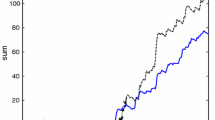Abstract
The current inefficient utilization of frequency spectrum has alerted regulatory bodies to streamline improvements. Cognitive radio (CR) has recently received considerable attention and is widely perceived as a promising improvement tool in estimating, or equivalently sensing, the frequency spectrum for wireless communication systems. The cognitive cycle in CR systems is capable of recognizing and processing better spectrum estimation (SE) and hence promotes the efficiency of spectrum utilization. Among different SE methods, the multi-taper method (MTM) shows encouraging results. Further performance improvement in the SE for CR can be achieved by applying multiple antennas and combining techniques. This paper proposes a constructive development of SE using MTM, abbreviated as MTSE, and by employing multiple-input multiple-output (MIMO), parsed into separate parallel channels using singular value decomposition (SVD), and maximum ratio combining (MRC) configurations. Deviating from these improvements, however, multicarrier systems such as orthogonal frequency division multiplexing (OFDM) show inferior sensing performances due to the noise multiplicity generated and combined from all subcarrier channels. By means of the quadrature matrix form, the probabilities for such integrated settings of SE have been derived to reach at their approximate asymptotes. Numerical simulations revealed specific better performances stemmed from coupling the fashionable MTSE and MIMO technologies.









Similar content being viewed by others
References
Ali A, Hamouda W (2017) Advances on spectrum sensing for cognitive radio networks: theory and applications. IEEE Communications Surveys and Tutorials 19(2):1277–1303
Wang B, Liu K (2011) Advances in cognitive radio networks: a survey. IEEE J Select Topics Signal Process 5(1):5–23
Yucek T, Arslan H (2009) A survey of spectrum sensing algorithms for cognitive radio applications. IEEE Commun Surv Tutorials 11(1):116–130
Axell E, Leus G, Larsson EG, Poor HV (2012) Spectrum sensing for cognitive radio: state-of-the-art and recent advances. IEEE Signal Process Mag 29:101–116
Haykin S, Thomson DJ, Reed JH (2009) Spectrum sensing for cognitive radio. Proc IEEE 97(5):849–877
Haykin S (2005) Cognitive radio: brain-empowered wireless communications. IEEE Trans Select Areas Commun 23(2):201–220
Ma J, Li GY, Juang BH (2009) Signal processing in cognitive radio. Proc IEEE 97(5):805–823
Wang J, Zhang QT (2009) A multitaper spectrum based detector for cognitive radio. Proc Conf Wireless Communications and Networks, Budapest, Hungary, pp 1–5
Zhang Q (2011) Multitaper based spectrum sensing for cognitive radio: design and performance. Proc Conf Vehicular Technology, Yokohama, Japan, pp 1–5
Jataprolu MK, Koilpillai RD, Bhashyam S (2012) Optimal MTM spectral estimation based detection for cognitive radio in HDTV. Proc Nat Conf Communications, Kharagpur, India, pp 1–5
Yu T, Parera S, Markovic D, Cabric D (2010) Cognitive radio wideband spectrum sensing using multitap windowing and power detection with threshold adaptation. Proc Int Conf Communications, Cape Town, South Africa, pp 1–6
Gismalla EH, Alsusa E (2012) New and accurate results on the performance of the multitaper-based detector. Proc Int Conf Communications, Ottawa, Canada, pp 1609–1613
Yousif EHG, Ratnarajah T, Sellathurai M (2015) Modelling and performance analysis of multitaper detection using phase-type distributions over MIMO fading channels. IEEE Trans on Signal Processing 63(22):5882–5896
Alghamdi OA, Abu-Rgheff MA (2010) Local MTM-SVD based spectrum sensing in SIMO OFDM cognitive radio under bandwidth constraint. Proc Int Conf Cognitive Radio Oriented Wireless Networks and Communications, Cannes, France, pp 1–6
Stuber GL, Barry JR, McLaughlin SW, LI Y, Ingram MA, Pratt TG (2004) Broadband MIMO-OFDM wireless communications. Proc of the IEEE 92(2):271–294
Hwang T, Yang C, Wu G, Li S, Li GY (2009) OFDM and its wireless applications: a survey. IEEE Trans Veh Technol 58(4):1673–1694
Mahmoud HA, Yucek T, Arslan H (2009) OFDM for cognitive radio: merits and challenges. IEEE Wirel Commun 16:6–14
Gupta A, Jha RK (2015) A survey of 5G network: architecture and emerging technologies. IEEE Access 3:1206–1232
Brennan D (2003) Linear diversity combining techniques. Proc of the IEEE 91(2):331–356
Clerckx B, Oestges C (2013). MIMO wireless networks: channels, techniques and standards for multi-antenna, multi-user and multi-cell systems. Academic Press, 2013
Goldsmith A (2005). Wireless communications. Cambridge University Press
Al-Juboori S, Fernando X (2015) Unified approach for performance analysis of cognitive radio spectrum sensing over correlated multipath fading channels. Proc IEEE Int Sym World of Wireless, Mobile and Multimedia Networks, Boston, USA, pp 1–6
Kuppusamy V, Mahapatra R (2008) Primary user detection in OFDM based MIMO cognitive radio. Proc Int Conf Cognitive Radio Oriented Wireless Networks and Communications, Singapore, pp 1–5
Nafkha A, Aziz B (2014) Closed-form approximation for the performance of finite sample-based energy detection using correlated receiving antennas. IEEE Wireless Communications Letters 3(6):577–580
Wang N, Gao Y (2013) Optimal threshold of Welch’s periodogram for sensing OFDM signals at low SNR levels. Proc Conf European Wireless, Guildford, UK, pp 1–5
Joshi DR, Popescu DC, Dobre OA (2010) Dynamic threshold adaptation for spectrum sensing in cognitive radio systems. Proc IEEE Radio and Wireless Symposium, New Orleans, USA, pp 468–471
Kay SM (1998). Fundamentals of statistical signal processing: detection theory Prentice-Hall PTR
Quan Z, Cui S, Sayed AH, Poor HV (2009) Optimal multiband joint detection for spectrum sensing in cognitive radio networks. IEEE Trans Signal Process 57(3):1128–1140
Bogale TE, Vandendorpe L, Le LB (2015) Wideband sensing and optimization for cognitive radio networks with noise variance uncertainty. IEEE Trans Commun 63(4):1091–1105
Taherpour A, Gazor S, Kenari MN (2008) Wideband spectrum sensing in unknown white Gaussian noise. IET Commun 2(6):763–771
Qing H, Liu Y, Xie G, Gao J (2015) Wideband spectrum sensing for cognitive radios: a multistage Wiener filter perspective. IEEE Signal Processing Letters 22(3):332–335
Betlehem T, Coulson AJ, Reid AB (2010) Wide-band spectrum sensing for cognitive radio by combining antenna signals. Proc Australian Communications Theory Workshop, Canberra, Australia, pp 111–116
Author information
Authors and Affiliations
Corresponding author
Additional information
Publisher’s note
Springer Nature remains neutral with regard to jurisdictional claims in published maps and institutional affiliations.
Rights and permissions
About this article
Cite this article
Abdul Salam, A.O., Sheriff, R.E., Al-Araji, S.R. et al. Spectrum sensing in cognitive radio using multitaper method based on MIMO-OFDM techniques. Ann. Telecommun. 74, 727–736 (2019). https://doi.org/10.1007/s12243-019-00710-0
Received:
Accepted:
Published:
Issue Date:
DOI: https://doi.org/10.1007/s12243-019-00710-0




